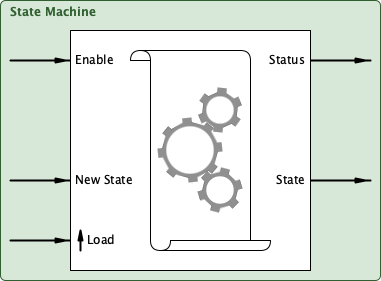
|
Control
State Machine
|
| Description | State Machine
|
| Availability |
|
| savvy-SFD Graphic |  |
| Graphic with Parameters |  |
| Enable |
Input, Read-write, Boolean (signed 16-bit integer) State Machine - Enable
0 = Disabled 1 = Enabled |
| New State |
Input, Read-write, Enumerated (signed 16-bit integer) State Machine - New State
0 = Disabled 1 = 1 |
| Load New State |
Input, Read-write, Boolean (signed 16-bit integer) State Machine - Load New State
0 = Low 1 = High |
| Status |
Output, Read-only, Enumerated (signed 16-bit integer) State Machine - Status
0 = Disabled 1 = Running 2 = No Program 3 = Missing State 4 = Malformed Program 5 = Set Failed 6 = Set to Invalid Address 7 = Set to Inactive Parameter 8 = Set to Read-Only 9 = Set to Connected 10 = Get Failed 11 = Get to Invalid Address 12 = Get to Inactive Parameter 13 = Unknown Instruction |
| Current State |
Output, Read-only, Enumerated (signed 16-bit integer) State Machine - State
0 = Disabled |
| Program |
Internal Parameter, Read-write, State Machine Program (Byte Array) State Machine - Program
|
| Persistence |
Internal Parameter, Read-write, Enumerated (signed 16-bit integer) State Machine - Persistence
0 = Disable on power-up 1 = Persistent 2 = Load on power-up |